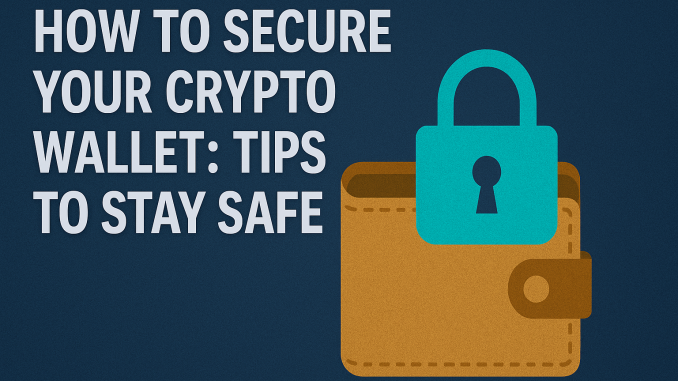
As cryptocurrency adoption grows, so do the risks of theft, hacking, and scams. Whether you’re holding Bitcoin, Ethereum, or altcoins, your crypto wallet security should be your top priority.
In this guide, we’ll walk you through how to secure your crypto wallet, explore the different wallet types, and share expert tips to keep your digital assets safe.
Why Crypto Wallet Security Matters
Unlike banks or centralized platforms, crypto wallets give you full control over your funds. That also means you are 100% responsible for protecting them.
If your private key or seed phrase is compromised, there’s no “reset password” option—your funds could be gone forever.
SEO Keywords: crypto wallet security, protect Bitcoin wallet, avoid crypto theft
Types of Crypto Wallets (and Their Security Levels)
🔐 1. Hardware Wallets (Cold Wallets) – Most Secure
These are physical devices like Ledger Nano X or Trezor, which store your private keys offline.
Pros:
-
Immune to online hacks
-
Ideal for long-term storage
Cons:
-
Can be lost or damaged if not backed up properly
SEO Keywords: best hardware wallet, cold storage crypto, Ledger vs Trezor
📱 2. Software Wallets (Hot Wallets) – Convenient but Risky
These wallets are apps on your phone or computer, like MetaMask, Trust Wallet, or Exodus.
Pros:
-
Easy to use for daily transactions
-
Free and fast setup
Cons:
-
Vulnerable to malware, phishing, or SIM swap attacks
SEO Keywords: hot wallet safety, MetaMask protection, software wallet security
🌐 3. Web Wallets and Exchanges – High Risk if Unsecured
Some people store crypto directly on exchanges like Binance, Coinbase, or Kraken.
Pros:
-
Easy for beginners
-
Integrated trading tools
Cons:
-
Exchange hacks and outages are still common
-
Not your keys, not your crypto
SEO Keywords: storing crypto on exchange, Coinbase wallet safety, centralized wallet risks
Top 10 Tips to Secure Your Crypto Wallet
✅ 1. Use Strong, Unique Passwords
Never reuse passwords. Use a password manager like Bitwarden or 1Password.
✅ 2. Enable Two-Factor Authentication (2FA)
Use apps like Google Authenticator instead of SMS-based 2FA, which is vulnerable to SIM swapping.
✅ 3. Back Up Your Recovery Phrase (Seed Phrase)
Write it down on paper or metal and store it in a secure place. Never take screenshots or save it on cloud storage.
✅ 4. Avoid Public Wi-Fi When Accessing Wallets
Use a VPN or mobile data if you must access your wallet while on the go.
✅ 5. Beware of Phishing Links and Fake Apps
Always verify URLs and download wallets from official websites or trusted app stores.
✅ 6. Keep Your Software Updated
Update your wallet, browser, and antivirus software regularly to avoid known vulnerabilities.
✅ 7. Don’t Share Wallet Info on Social Media
Scammers often target users who reveal wallet addresses, balances, or screenshots online.
✅ 8. Use a Hardware Wallet for Large Holdings
Store most of your assets offline and only keep a small amount in hot wallets for daily use.
✅ 9. Test Transfers with Small Amounts
Always send a small test amount before transferring large sums of crypto.
✅ 10. Create a Will or Backup Plan
Make sure someone you trust knows how to access your wallet in case something happens to you.
SEO Keywords: crypto wallet protection tips, how to avoid crypto scams, crypto seed phrase safety
Extra: Common Crypto Security Mistakes to Avoid
-
Reusing the same wallet on multiple devices
-
Leaving coins on shady or unregulated exchanges
-
Falling for “free airdrop” scams on social media
Stay skeptical, stay private, and verify before you trust.
Final Thoughts: Stay Safe in the Crypto World
Securing your crypto wallet is not optional—it’s essential. With just a few smart habits and tools, you can drastically reduce your risk of loss or theft.
Leave a Reply